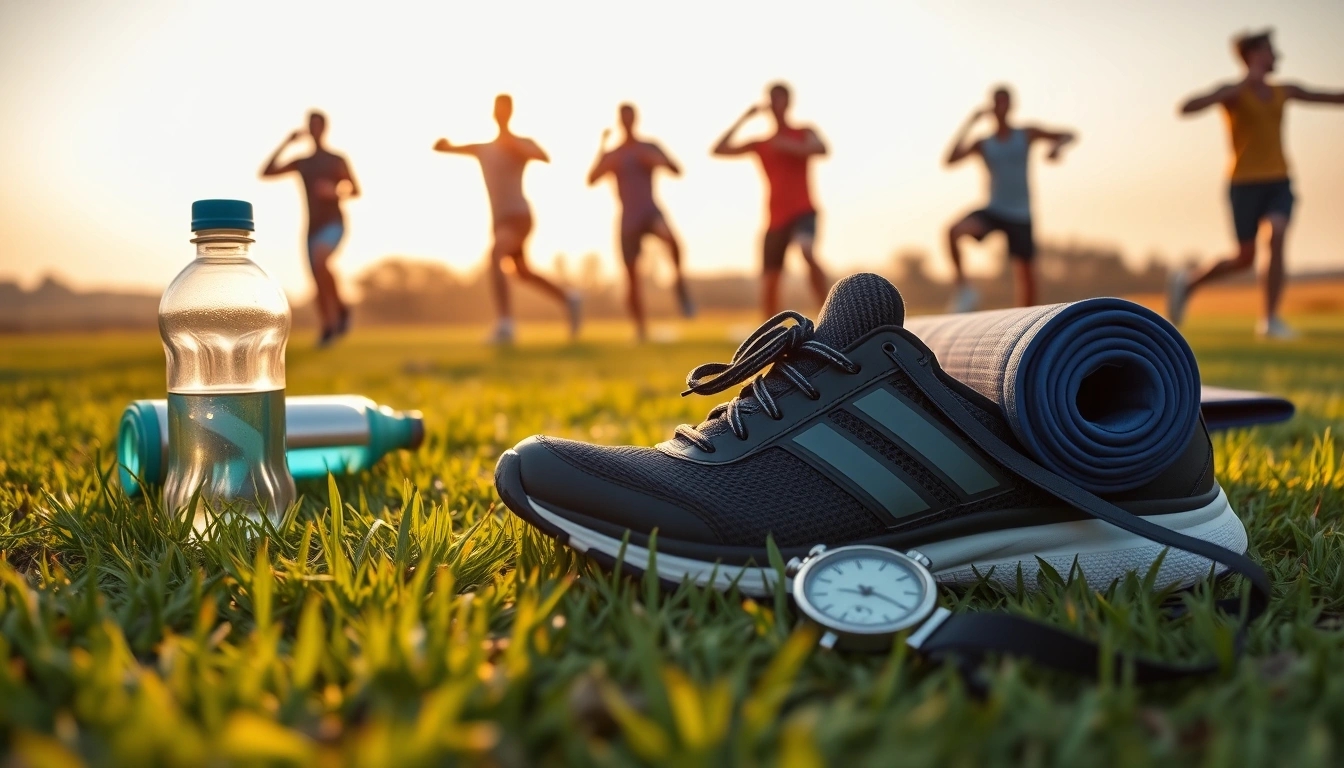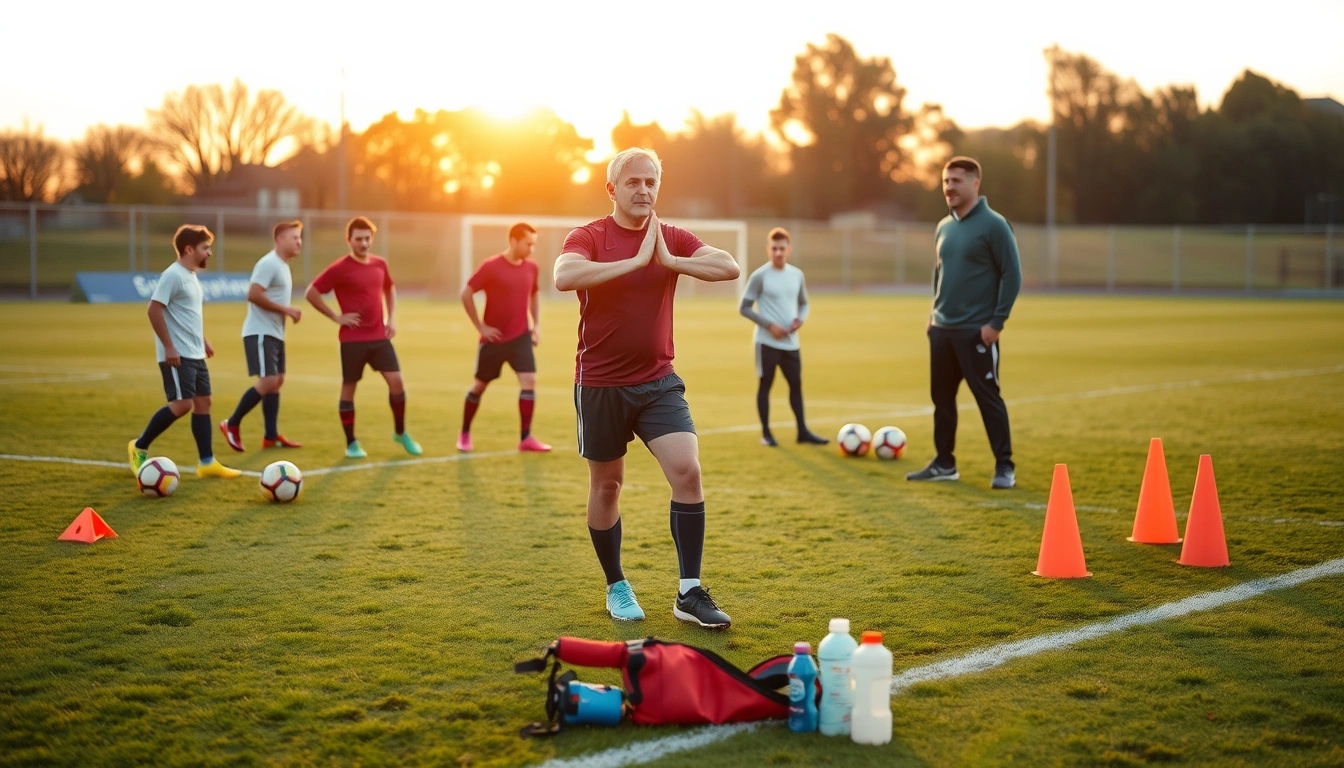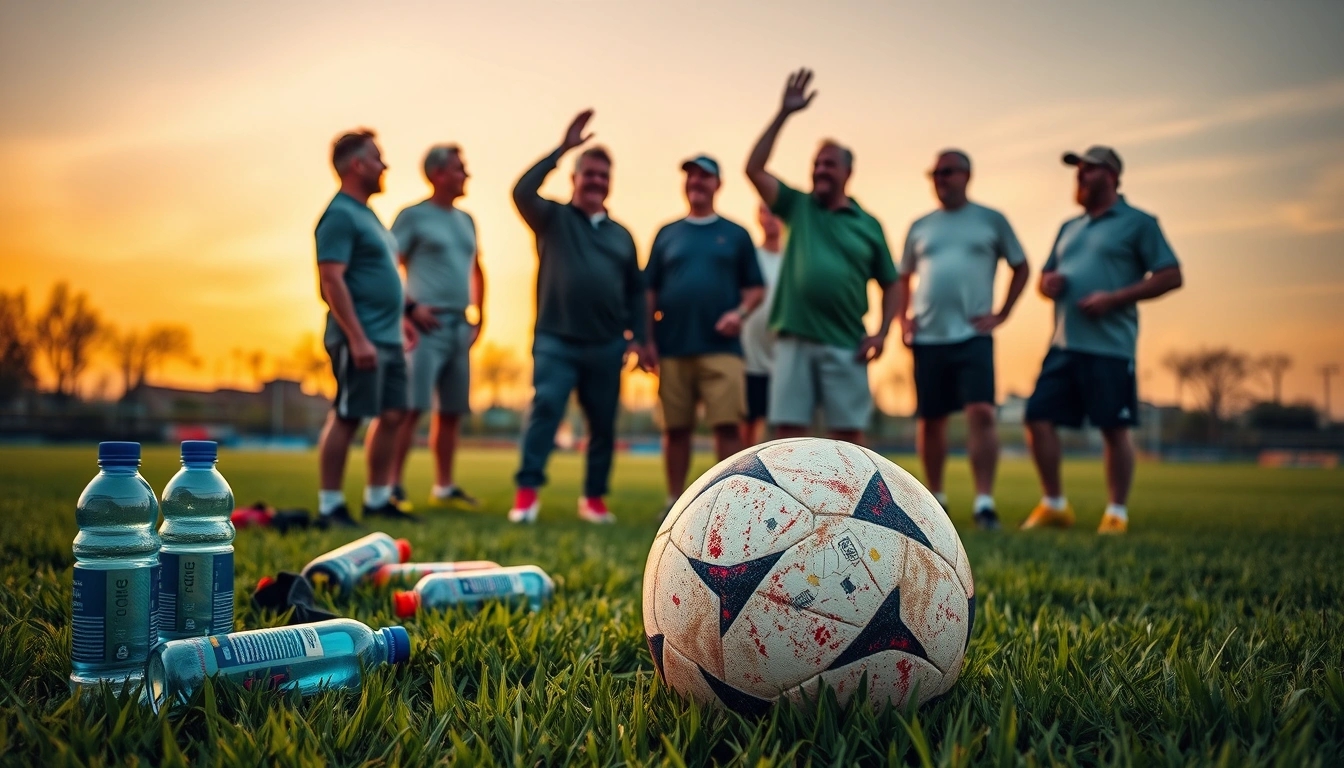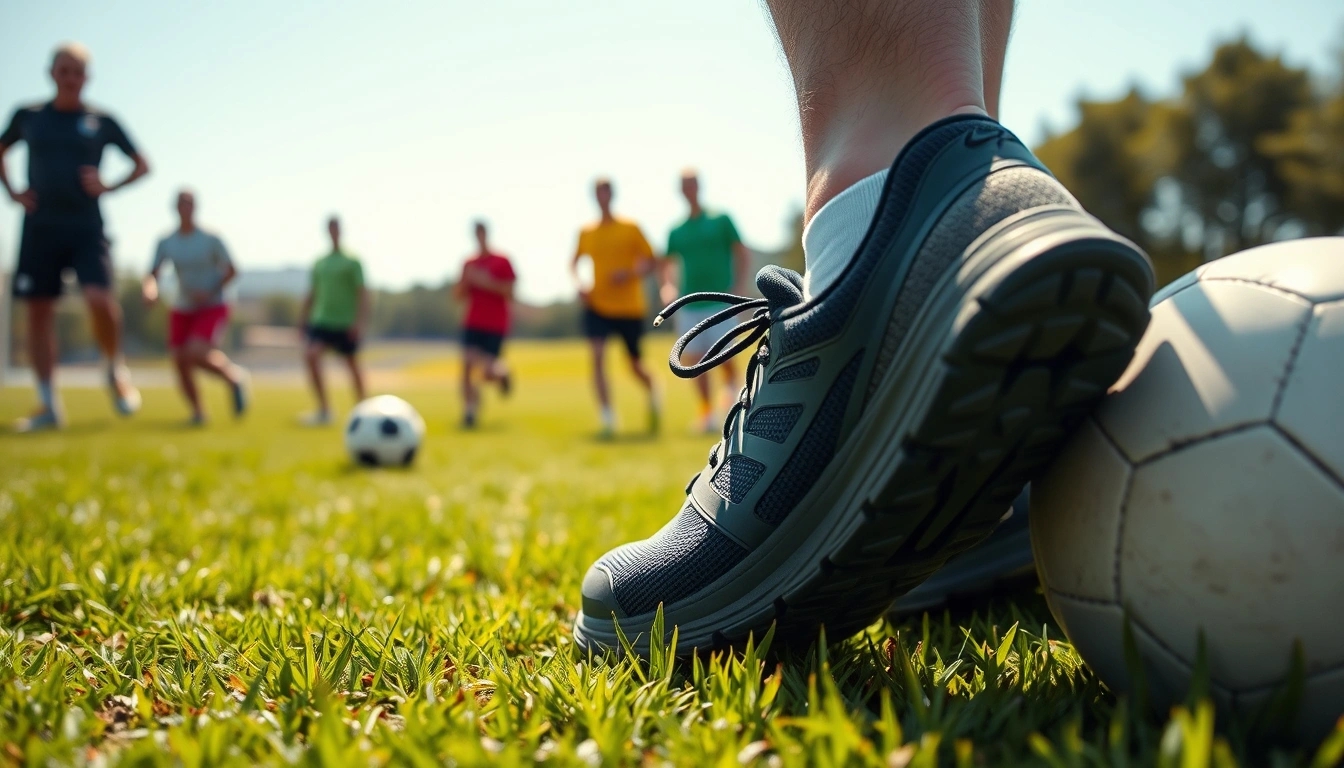Alright, let’s cut to the chase—getting active in your 50s doesn’t have to mean lonely jogs or endless gym hours staring at the wall. Team sports are where it’s at! Not only do they keep you moving, but they also sprinkle in some much-needed social vibes and a pinch of that old competitive fire. You know, the kind that makes you want to show off just a little (or a lot). So, how exactly do you jump into this world without feeling like a fish outta water? Here’s the lowdown.
Why team sports rock for the 50-plus crowd
Let’s be honest, team sports aren’t just reserved for the twenty-somethings trying to prove something. For us seasoned folks, they’re a goldmine. You get a full-body workout that’s actually fun, not a chore. Plus, the social aspect? Huge. Making new friends, sharing laughs, and yes, the occasional trash talk (all in good spirit) can seriously boost your motivation. It’s like killing two birds with one stone—fitness and friendship.
| Benefit | Why It Matters |
|---|---|
| Social bonding | Keeps loneliness at bay and boosts mental health |
| Motivation | Teammates push you to show up and give your best |
| Full-body workout | Improves strength, flexibility, and endurance |
Picking the right sport: what suits your body and mood?
Here’s the kicker—you gotta pick a sport that doesn’t make your knees scream for mercy the next day. Low-impact options like swimming, bowling, or even pickleball are fantastic. They get your heart rate up without turning your joints into a disaster zone. And hey, if you’re not feeling team sports that are too intense, no shame in trying something chill but social. The key is sticking with it.
- Consider your current fitness level
- Think about what excites you (yes, excitement matters!)
- Don’t be afraid to try new things—variety keeps boredom away
Warm-ups and cool-downs: don’t skip these lifesavers
Look, I get it—warm-ups can feel like a waste of time when you’re itching to get on the court or field. But trust me, skipping them is like inviting injuries to crash your party. Gentle stretches and light cardio get your muscles ready and help prevent those pesky strains. After the game? Cool-downs help your body chill out and recover, which is pretty much a must when you’re not 25 anymore.
Balancing cardio and strength in team sports
Team sports naturally mix cardio and strength, but if you go all out and leave your muscles drained, you might be sidelined for days. Balance is everything. Think of it like seasoning a good stew—you want enough spice (cardio) but not so much that it burns out the flavor (muscle strength). Incorporate some strength training on off days to keep your muscles happy and resilient.
| Focus | Examples | Why It Helps |
|---|---|---|
| Cardio | Running, cycling, fast-paced games | Boosts heart health and stamina |
| Strength | Bodyweight exercises, resistance bands | Supports joints and prevents injuries |
Nutrition tips to fuel your game and recovery
You can’t out-train a bad diet, no matter how hard you try. Protein is your best friend here—it helps repair muscles after a tough match. Carbs give you the energy to keep going, and don’t forget healthy fats for joint health. Hydration? Non-negotiable. Water is like the oil that keeps your engine running smooth.
Dealing with aches and pains: when to push and when to pause
Here’s the tricky part. Some aches are just your body’s way of saying “Hey, you worked hard!” But that nagging pain that won’t quit? Don’t be a hero. Rest is part of the game. Ice, elevate, and if it’s serious, see a pro. Remember, you wanna be in this for the long haul, not sidelined forever.
- Listen closely to your body’s signals
- Don’t ignore sharp or persistent pains
- Use rest days smartly to recover
Staying motivated: how to keep showing up week after week
Motivation can be a slippery beast. Some days you’re pumped, other days you’d rather binge-watch TV. Find a squad that makes you laugh, set small goals that feel doable, and celebrate every win—even if it’s just showing up. Sometimes, the best motivation is just not wanting to let your team down.
Social perks: more than just fitness gains
Beyond the sweat and sore muscles, team sports give you a sense of belonging—something that’s priceless as we age. New friendships, networking, and just plain fun can make all the difference in your overall happiness.
Gear up smart: what you really need for comfort and safety
You don’t need to break the bank, but investing in good shoes and protective gear can save you from a world of hurt. Comfort and safety first, always.
Adapting to changes: flexibility in your routine
Life’s unpredictable. Injuries, work, family—stuff happens. Being flexible with your routine means you don’t throw in the towel at the first hiccup. Modify, rest, come back stronger.
Tracking progress without obsessing over numbers
Keep an eye on how you’re doing, but don’t let numbers stress you out. Celebrate improvements in energy, mood, and how your clothes fit instead.
Success stories: inspiration from 50-somethings thriving in team sports
There are tons of folks in their 50s smashing it in team sports—proving you’re never too old to get in the game. Their stories are proof that with the right mindset, a bit of grit, and a good team, staying fit and having fun go hand in hand.
So, lace up those shoes, find your team, and dive in. Your 50s are just the beginning of a new, active chapter. Don’t let anything hold you back!
Why team sports rock for the 50-plus crowd
Alright, let’s get real for a second. When you hit your 50s, the idea of jumping into a fast-paced team sport might sound like a recipe for disaster—or at least a ticket to some serious muscle soreness. But guess what? Team sports aren’t just playground antics for the young guns; they’re actually a goldmine for folks in their 50s looking to stay fit, sharp, and socially alive. Don’t believe me? Stick around, and I’ll break down why lacing up those sneakers for a team game might just be your best move yet.
First off, social bonding. It’s easy to underestimate how much hanging out with teammates can boost your mood and motivation. When you’re part of a team, you’re not just exercising; you’re joining a little community. That weekly game isn’t just a workout—it’s catching up, laughing off missed shots, and yes, sometimes trash-talking (all in good fun). Science even backs this up: social connections can help reduce stress and keep your brain sharper. So, it’s not just your muscles getting a workout, but your mental well-being too.
| Benefits of Team Sports for 50-Plus | Details |
|---|---|
| Full-body workout | Engages multiple muscle groups, improving strength, balance, and coordination. |
| Motivation boost | Team spirit keeps you coming back, even on days you’d rather binge-watch TV. |
| Social interaction | Builds friendships and combats loneliness, a common issue as we age. |
| Mental sharpness | Strategizing and quick decision-making keep your brain active. |
Now, I’m not saying you need to sign up for the next NBA draft. The beauty of team sports in your 50s is the variety and adaptability. Whether it’s a casual soccer league, a friendly volleyball match, or even something like pickleball (which is blowing up for good reasons), there’s something that fits every energy level and joint condition. Low-impact options are a lifesaver here—keeping your heart rate up without feeling like you’ve been hit by a truck the next day.
- Pick sports that offer flexibility: You can scale intensity, so you’re not sidelined by aches.
- Look for social clubs: Many communities have groups specifically for 50+ players.
- Don’t be shy: Everyone’s there for the fun and fitness, not to judge your skills.
And let’s talk about motivation—because, let’s face it, sometimes the couch looks way more inviting than the court. Being on a team means you’ve got a built-in support system. You’re accountable to others, which is a sneaky but effective way to keep showing up. Plus, the competitive spirit—even if it’s just friendly banter—adds a little spice to your routine.
Quick Tip:If you’re feeling a bit rusty, start with half-games or practice sessions.Build up your stamina gradually; nobody expects you to run marathons.Embrace the occasional clumsy moment—it’s all part of the fun!
So, if you’re wondering whether team sports are just for the young and restless, think again. For the 50-plus crowd, they’re a fantastic blend of exercise, social life, and mental challenge—all wrapped up in a fun package. Dust off those cleats, grab a buddy, and dive in. Your body and mind will thank you, even if your knees grumble a bit along the way.
In summary: Team sports aren’t just a workout; they’re a lifestyle boost that keeps you connected, motivated, and moving. And honestly, isn’t that what staying fit in your 50s is all about?
Picking the right sport: what suits your body and mood?
Alright, let’s be real for a sec—choosing a sport when you hit your 50s isn’t like picking your favorite candy as a kid. Your body’s throwing curveballs, your energy levels are doing their own dance, and honestly, your mood might be swinging more than a playground swing. So, before you jump headfirst into some hardcore basketball league or sign up for a marathon (yikes), it’s crucial to find a sport that vibes with both your physical limits and what you actually enjoy.
Why bother with low-impact? Because, my friend, your joints aren’t exactly spring chickens anymore. High-impact sports might sound thrilling, but they can leave you hobbling around like you just survived a wrestling match with a bear. Instead, think about activities that get your heart rate up without smashing your knees or ankles into oblivion. Swimming, cycling, or even a chill game of pickleball can do wonders. They’re like the Goldilocks of sports—not too rough, not too boring.
- Swimming: Full-body workout, zero joint stress, and hey, you get to splash around like a kid again.
- Walking Soccer: Yep, it’s a thing! All the fun of soccer without the sprinting madness.
- Volleyball: Great for hand-eye coordination and socializing, plus it’s easy on the knees.
Now, don’t just pick a sport because your buddy’s doing it or because you saw it on TV. If your heart’s not in it, you’ll bail faster than a cat at bath time. Ask yourself: “Do I wanna sweat it out or just move enough to feel alive?” Sometimes, the best sport is the one that makes you laugh, chat, and forget you’re actually exercising.
| Sport | Impact Level | Best For | Potential Drawbacks |
|---|---|---|---|
| Swimming | Low | Joint issues, full-body fitness | Access to pool needed |
| Walking Soccer | Low | Social play, light cardio | Less intense workout |
| Volleyball | Moderate | Coordination, team fun | Jumping can strain knees |
| Golf | Low | Leisurely pace, social | Limited cardio |
| Basketball (recreational) | Moderate to High | Cardio and agility | Risk of injury |
Also, mood matters. If you’re the type who thrives on competition, maybe a sport with a bit of a challenge will keep you hooked. But if you’re more of a “let’s chill and chat” person, something less intense might be your jam. Remember, sticking with a sport long-term is about enjoyment as much as fitness.
Tips to pick your perfect sport:- Try a few different options before committing.- Listen to your body; pain is a red flag, not a badge of honor.- Find a group or club to keep things social and fun.- Don’t be afraid to switch it up if your first pick isn’t clicking.
Bottom line? There’s no one-size-fits-all here. Your 50s are the perfect time to experiment, discover what makes you tick, and maybe even surprise yourself. So, lace up those sneakers or grab that paddle, but most importantly, make sure you’re having a blast while you’re at it. Because if it feels like a chore, you’ll quit faster than you can say “team sports.” And that’s the last thing we want.

Warm-ups and cool-downs: don’t skip these lifesavers
Alright, let’s get real for a second. If you’re in your 50s and diving into team sports, you might be tempted to skip those warm-ups and cool-downs. Been there, done that, right? But here’s the kicker: your body isn’t bouncing back like it did in your 20s. That little spring in your step? Yeah, it’s more like a slow-mo jog. So, warming up and cooling down isn’t just some boring ritual; it’s your body’s best friend to avoid injuries and keep you playing week after week.
Why bother with warm-ups? Imagine trying to sprint without stretching your legs first — ouch! Warm-ups get your blood flowing, raise your heart rate gradually, and loosen up those stiff muscles and joints. Without it, you’re basically asking for a pulled muscle or worse.
- Start slow: Begin with 5-10 minutes of light cardio — think brisk walking or easy cycling.
- Stretch it out: Focus on dynamic stretches like leg swings, arm circles, or lunges to prep the muscles you’ll use in the game.
- Activate muscles: Some light drills or sport-specific movements get your nervous system ready to fire on all cylinders.
Skipping this step? You’re rolling the dice with your hamstrings and knees. And trust me, you don’t want to be sidelined with an injury that could’ve been avoided by just 10 minutes of prep.
Now, onto cool-downs. After you’ve given it your all, your body needs some TLC to recover properly. Jumping straight into the shower or couch potato mode might feel tempting, but cooling down helps lower your heart rate gradually and flushes out metabolic waste from your muscles.
| Method | Benefits | Duration |
|---|---|---|
| Light Jog or Walk | Gradually reduces heart rate and breathing | 5-10 minutes |
| Static Stretching | Helps muscles relax and improves flexibility | 5-10 minutes |
| Deep Breathing Exercises | Promotes relaxation and lowers cortisol levels | 2-3 minutes |
And don’t just stretch willy-nilly. Hold each stretch for at least 20-30 seconds, focusing on the muscles you worked the hardest. I know, it sounds like a snooze fest, but your future self will thank you when you’re not hobbling around the next day.
Here’s a quick checklist to keep in mind:
- Warm-up: 5-10 mins light cardio + dynamic stretches
- Cool-down: 5-10 mins light jogging/walking + static stretches
- Hydrate: Drink water before, during, and after to keep those muscles happy
Look, I get it — sometimes you just want to jump straight into the game or crash after it’s over. But think of warm-ups and cool-downs as your secret weapon to stay in the game longer, avoid those pesky injuries, and keep feeling good. Because honestly, nothing kills the fun faster than being benched with a pulled muscle or stiff joints.
So next time you lace up, don’t just stand there like a statue — get moving, stretch it out, and wrap it up right. Your body isn’t getting any younger, but with a little care, it’ll keep you on the field, court, or pitch for many more seasons to come.
Balancing cardio and strength in team sports
Alright, let’s get real for a moment. Team sports are like this wild cocktail of cardio and strength training thrown together — sometimes perfectly mixed, sometimes a hot mess. If you’re in your 50s and jumping into the game, it’s not just about showing up and sweating buckets. It’s about figuring out how to balance that heart-pumping cardio with the muscle-building strength work so you don’t end up feeling like a total zombie after every match.
First off, team sports naturally demand a bit of everything. Think about it: you’re running, sprinting, dodging (cardio), but also pushing, pulling, jumping, and sometimes even wrestling for the ball (hello, strength!). But here’s the kicker — if you lean too hard on one side, say all cardio with no strength, you might get tired quicker or even risk injury. On the flip side, focusing only on strength without enough cardio can leave you gasping for air halfway through the game. So, how do you keep it balanced?
- Mix it up during practice: Don’t just run laps endlessly. Incorporate strength drills like bodyweight exercises — squats, lunges, push-ups — right into your warm-up or cool-down. They don’t have to be crazy intense, just enough to keep muscles engaged.
- Intervals are your friend: High-intensity interval training (HIIT) mimics the stop-and-go nature of most team sports. Sprint a short distance, then jog or walk, repeat. This keeps your heart in shape and builds explosive power.
- Listen to your body: If you’re wiped out after games, it’s a sign you might be overdoing it on one side of the balance. Adjust your training accordingly.
| Aspect | Cardio Focus | Strength Focus | Balanced Approach |
|---|---|---|---|
| Energy Use | High endurance, stamina | Power bursts, muscle force | Endurance + power for sustained performance |
| Risk | Fatigue, burnout | Muscle strain, joint stress | Reduced injury risk with proper recovery |
| Example Exercises | Sprints, jogging, cycling | Weight training, resistance bands | Circuit training, HIIT |
Now, here’s a little secret — you don’t have to be perfect at balancing every single session. Some days you’ll feel pumped for a cardio-heavy practice; other days, you might wanna focus on strength and recovery. The key is to keep the overall weekly routine balanced. And don’t forget: recovery days are just as important as training days. Stretching, foam rolling, and even a leisurely walk can do wonders.
One more thing — team sports come with a social bonus that solo workouts don’t. That buddy cheering you on or the friendly competition can push you to work harder without even realizing it. Use that energy to your advantage but don’t get carried away trying to keep up with younger players or your own past self. Your 50s body isn’t the 20s version, and that’s okay!
Tips for Balancing Cardio & Strength in Team Sports:- Start with a dynamic warm-up: light jogging + mobility drills- Incorporate strength exercises 2-3 times a week (bodyweight or light weights)- Use interval training to boost both cardio and power- Prioritize rest and listen to aches — don’t ignore nagging pains- Hydrate and fuel your body properly before and after games
In the end, balancing cardio and strength in team sports isn’t rocket science, but it does require some trial and error. Don’t be afraid to experiment, adjust, and yes, even fail sometimes. The goal? To keep playing, keep moving, and keep enjoying the game without feeling wiped out or sidelined. Because, honestly, isn’t that what it’s all about?
Nutrition tips to fuel your game and recovery
Look, if you think you can just show up to your team sport, swing your limbs around, and then chow down on whatever junk’s lying around the house, think again. Eating right is not just half the battle—it’s the secret sauce that keeps you energized, helps your muscles bounce back, and keeps you feeling spry enough to actually enjoy the next match instead of crawling off the field like a zombie. Seriously, fueling your body properly is a game-changer, especially when you’re rocking the 50-plus club. Your metabolism isn’t what it used to be, and your recovery time? Let’s just say it’s not as speedy as your grandkid’s. So, what should you be stuffing your plate with? Here’s the lowdown.
- Carbs aren’t the enemy: Sure, we’ve all heard the low-carb gospel, but carbs are your muscles’ favorite fuel during a game. Think whole grains, sweet potatoes, and fruits. They give you that steady energy without the crash.
- Protein is your muscle’s best friend: After you’ve busted a gut chasing that ball, your muscles need repair. Lean meats, fish, beans, and nuts help rebuild those fibers so you’re not hobbling around for days.
- Don’t forget healthy fats: Avocados, olive oil, and fatty fish like salmon keep inflammation down and your joints happy. Because, let’s face it, creaky knees are no fun.
| Meal Timing | What to Eat | Why It Matters |
|---|---|---|
| Pre-game (1-2 hours before) | Banana, whole grain toast, peanut butter | Provides quick energy without feeling heavy |
| During game | Water, electrolyte drinks (if intense) | Stay hydrated, maintain electrolyte balance |
| Post-game (within 30 mins) | Protein shake, yogurt with berries | Kickstarts muscle repair and recovery |
| Evening meal | Grilled chicken, quinoa, steamed veggies | Replenishes glycogen and provides nutrients for overnight recovery |
Now, hydration—don’t even get me started. You might think you’re drinking enough, but dehydration sneaks up on you like a sneaky defender. Water is your best mate, plain and simple. If you’re sweating buckets, toss in some electrolyte drinks to keep your muscles firing on all cylinders. No one wants cramps ruining their game, right?
And hey, supplements? They’re not magic pills. If you’re eating a balanced diet, you probably don’t need a ton of extras. But a little vitamin D, omega-3s, or magnesium can help if your diet’s a bit all over the place. Just don’t go overboard thinking you’re some kind of superhero.
Practical Nutrition Tips:- Plan your meals around your game schedule.- Avoid heavy, greasy foods before playing—they’ll slow you down.- Snack smart: nuts, fruit, or a small yogurt are better than chips.- Listen to your body—if you’re hungry, eat, but don’t stuff yourself.
Remember, the goal isn’t to become a nutritionist overnight or turn your life upside down. It’s about making smarter choices that keep you feeling good, performing well, and recovering fast enough to do it all again next week. Because let’s be honest, there’s nothing worse than sitting out because you didn’t fuel right. So, gear up your plate as well as your gear, and get ready to crush that next game.

Dealing with aches and pains: when to push and when to pause
Alright, let’s get real for a moment—if you’re in your 50s and still hitting the field or court, you’ve probably noticed that your body doesn’t exactly bounce back like it used to. Those little nagging aches? Yeah, they seem to pop up uninvited, like that one teammate who never knows when to shut up. But here’s the kicker: knowing when to grit your teeth and push through versus when to throw in the towel (or at least take a breather) is an art form. And trust me, it’s not always obvious.
First off, listen to your body. Sounds cliché, I know, but it’s the golden rule. That dull, persistent ache in your knee or shoulder isn’t just background noise—it’s your body waving a red flag. Ignoring these signals might feel like you’re toughing it out, but more often than not, you’re just setting yourself up for a longer downtime. Here’s a quick checklist to help you figure out what’s what:
| Symptom | Push Through? | Pause & Rest? |
|---|---|---|
| Mild muscle soreness after a game | Yes – normal and expected | No |
| Sharp or shooting pain during activity | No | Yes – stop immediately |
| Swelling or bruising around a joint | No | Yes – seek medical advice |
| Fatigue without muscle pain | Maybe – listen carefully | Sometimes – if it’s persistent |
Now, here’s a curveball: sometimes, the mind wants to play hero, shouting “No pain, no gain!” But your body? It’s more like a grumpy old coach reminding you to chill out. The trick is to differentiate between the good pain (hello, muscle burn!) and the bad pain (cue the limping). And if you’re unsure, err on the side of caution. Nobody wants to be sidelined for weeks because they ignored a warning sign.
- Tip #1: Warm up properly. Cold muscles + sudden intense activity recipe for disaster.
- Tip #2: Use ice packs or heat therapy post-game for those stubborn aches.
- Tip #3: Don’t be shy about consulting a physiotherapist or sports doc—these folks are your best friends.
Remember, it’s not about being the toughest player out there; it’s about being the smartest. Pushing through pain might earn you some street cred, but pushing through injury just means you’ll be watching the next match from the sidelines, eating popcorn (unless you like that, no judgment).
And hey, sometimes a little patience is all it takes. Rest days aren’t a punishment—they’re part of the game plan. Your body needs time to repair and strengthen, especially when you’re juggling the realities of aging joints and muscles. So, if you’re feeling beat up, take a step back, do some light stretching, maybe a bit of yoga or swimming, and come back stronger.
"Pain is temporary, pride is forever" – yeah, well, so is a torn ligament, so choose wisely.
In a nutshell, keep a sharp eye on those aches and pains, and don’t let stubbornness get the better of you. Your 50s are a fantastic time to stay active and enjoy team sports, but only if you treat your body with the respect it deserves. So, listen closely, push smartly, and pause when needed—you’ll thank yourself later.
Staying motivated: how to keep showing up week after week
Let’s be honest—motivation isn’t some magical fountain that flows endlessly, especially when you’re juggling life in your 50s. Some weeks, you feel like a rockstar ready to conquer the field, and other times, well… you’d rather binge-watch your favorite series in pajamas. It happens. The key? Finding ways to keep that spark alive so you don’t ghost your team or quit halfway through the season.
First off, surrounding yourself with the right crew is a game changer. You know those teammates who cheer you on, crack jokes, and make the whole experience less like a workout and more like a hangout? That’s the vibe you want. When your squad’s got your back, skipping practice suddenly feels like missing out on a party rather than a chore.
| Benefit | Why It Matters |
|---|---|
| Accountability | Knowing someone’s counting on you keeps you showing up. |
| Encouragement | Boosts confidence and helps push through tough days. |
| Fun Factor | Laughs and camaraderie make workouts less of a drag. |
Next up, setting realistic goals is crucial. Forget trying to be the MVP overnight or running circles around younger players. Instead, aim for achievable milestones—like improving your passing accuracy, attending 80% of practices, or simply getting through a whole game without feeling wiped out. Small wins add up and keep you pumped.
- Short-term goals: Focus on weekly or monthly targets to maintain momentum.
- Long-term goals: Think about where you want to be by season’s end, like better endurance or fewer injuries.
- Celebrate progress: Reward yourself for sticking to your plan, whether it’s a cheat meal or new gear.
Now, here’s a truth bomb: motivation will dip. No shame in that. What separates the champs from the quitters is how you handle those slumps. When enthusiasm wanes, try switching things up. Maybe try a new position, invite a friend to join, or even just remind yourself why you started in the first place. Sometimes, a little self pep talk goes a long way.
Tips for When Motivation Hits the Skids:- Change up your routine to keep it fresh.- Set mini-challenges with teammates.- Keep a journal of your progress and feelings.- Remember: rest days don’t mean failure—they’re part of the process.
Finally, embracing imperfection helps a ton. You’re not gonna nail every game or practice, and that’s okay. Sometimes you’ll be slower, sometimes less coordinated, but showing up consistently? That’s the real win. The goal isn’t perfection; it’s persistence.
So, lace up those sneakers, grab your water bottle, and dive back in—even if some days it feels like a struggle. Because staying motivated in your 50s isn’t about being flawless; it’s about keeping the fire alive, week after week, with a little grit, a good team, and a whole lot of heart.
Social perks: more than just fitness gains
Alright, let’s get real for a sec—team sports aren’t just about breaking a sweat or clocking in those cardio minutes. Sure, the physical perks are fantastic, but if you think that’s all you’re getting, you’re missing the bigger picture. The social perks? Oh boy, they’re the secret sauce that keeps people coming back, especially when you hit your 50s and beyond.
Imagine this: you show up for a weekly game and suddenly you’re surrounded by a crew who actually knows your name (and maybe your snack preferences). That sense of belonging—it’s priceless. It’s not just about the game; it’s about the chats, the laughs, the shared victories, and yes, even those groans when someone misses an easy shot. This camaraderie can seriously boost your mood and mental health, making you feel connected in a world that sometimes feels like it’s spinning too fast.
- Friendships that stick: Meeting people who share your interests can lead to lifelong friendships. It’s far easier to bond over a game than at a random social event.
- Networking opportunities: You never know when that teammate might turn out to be a business contact or a new hobby buddy.
- Support system: When life throws curveballs, having a team means having people who get it and can lift you up.
Now, don’t get me wrong—joining a team in your 50s might feel a bit intimidating at first. You might wonder if you’ll keep up or fit in. But here’s the thing: most teams are welcoming and appreciate the experience and perspective older players bring. Plus, the motivation to show up regularly is way higher when you know there are folks counting on you.
| Social Benefit | Why It Matters | How It Helps Your Fitness Journey |
|---|---|---|
| Friendships | Creates a sense of community and reduces loneliness | Increases consistency by making workouts fun and social |
| Networking | Opens doors to new opportunities and interests | Encourages engagement beyond just exercise |
| Support System | Provides emotional backing during tough times | Helps sustain long-term commitment to fitness goals |
And hey, let’s not forget the simple joy of belonging. Feeling like you’re part of something bigger than yourself is a huge boost to self-esteem. It’s like your own little tribe cheering you on, both on and off the field. Plus, the social interaction helps keep your brain sharp—win-win.
So, next time you’re thinking about skipping that team practice or game, remember: you’re not just working on your biceps or stamina. You’re investing in friendships, mental well-being, and a community that’s got your back. And honestly, that’s a pretty sweet deal for anyone, no matter your age.
Quick tips to maximize social perks in team sports:
- Show up early to chat and warm up — it’s where bonds often start.
- Volunteer for team roles like organizing snacks or scheduling — it deepens connections.
- Don’t be afraid to crack jokes or share stories — humor is a great icebreaker.
- Celebrate small wins together, on and off the field.
In the end, team sports in your 50s aren’t just about staying fit—they’re about staying connected, energized, and downright happy. So lace up those shoes, grab a buddy, and dive in. Your future self (and your social calendar) will thank you.

Gear up smart: what you really need for comfort and safety
Alright, let’s get real — diving into team sports in your 50s isn’t just about showing up and hoping for the best. Nope, the gear you pick can seriously make or break your whole experience. You don’t need to blow your paycheck on fancy stuff, but skimping on essentials? That’s a fast track to discomfort, injury, or just plain old frustration. So, what’s the lowdown on gearing up smart without emptying your wallet? Let’s break it down.
- Footwear: The Foundation of It All
If you think you can just rock any old sneakers, think again. Your feet take the brunt of every sprint, pivot, and jump. Invest in shoes that offer solid arch support, good cushioning, and a grip that won’t have you slipping like a newbie on ice. Don’t just grab what’s on sale; get fitted at a specialty store if possible. Your knees and back will thank you later. - Clothing: Comfort Meets Function
Forget the idea that you need to look like a pro athlete to play like one. Breathable, moisture-wicking fabrics are your best friends here — they keep sweat off your skin and help regulate temperature. Layering is key too, especially if you’re playing outdoors. A lightweight jacket or long-sleeve shirt can save you from that post-game chill. - Protective Gear: Don’t Skip It
Depending on the sport, some protective gear is non-negotiable. Think knee pads, mouthguards, or even lightweight helmets. It might feel like overkill at first, but trust me, dodging a nasty bruise or a chipped tooth is worth every penny. Plus, some gear nowadays is pretty sleek and won’t cramp your style.
Now, here’s a quick table to help you figure out what’s essential depending on the sport you pick:
| Sport | Must-Have Gear | Optional Extras |
|---|---|---|
| Soccer | Cleats, shin guards | Compression socks, ankle braces |
| Basketball | Supportive sneakers, mouthguard | Knee pads, sweatbands |
| Volleyball | Knee pads, court shoes | Finger tape, elbow sleeves |
| Softball/Baseball | Glove, cleats, helmet | Batting gloves, sliding shorts |
Look, comfort and safety don’t have to be mutually exclusive with budget-friendliness. Here’s a little cheat sheet to keep your wallet happy while still gearing up right:
- Shop off-season: That jersey or cleats you want? You’ll find better deals when the season’s over.
- Buy used or borrow: Some gear like gloves or pads can be found gently used online or through community groups.
- Prioritize: Spend more on shoes and protective gear; save on apparel and accessories.
And hey, don’t forget the little extras that make a big difference — a good water bottle, a sweat towel, or even a small first aid kit in your bag. These might not seem like gear per se, but they keep you comfortable and ready to roll.
To sum it up: smart gear choices better performance + injury prevention + more fun. It’s not rocket science, but it does take a bit of thought. So, before you lace up those shoes or slap on that jersey, think about what your body really needs to stay safe and comfy. Trust me, your 50-something self will give you a high-five for it later.
Adapting to changes: flexibility in your routine
Life, as we all know, doesn’t exactly hand you a perfect playbook when it comes to staying active, especially in your 50s. Injuries pop up out of nowhere, schedules get crazier than ever, and motivation? Well, let’s just say it sometimes takes a nosedive right when you need it most. That’s why having a flexible approach to your sports routine isn’t just a good idea—it’s an absolute game-changer. You gotta roll with the punches, or in sports terms, you gotta know when to pass, when to shoot, and when to just call a timeout.
- Injuries: Yeah, those pesky aches and pains that sneak in and mess with your groove. Instead of throwing in the towel, adapt your activities. Maybe swap out high-impact drills for some gentle swimming or cycling. Your body’s telling you something—listen up!
- Busy schedules: Work meetings, family stuff, or just life in general can throw a wrench in your training plans. Flexibility means squeezing in shorter sessions or mixing up your team practice with solo workouts. A quick 20-minute jog or some stretching can keep the momentum going.
- Motivation slumps: Happens to the best of us. When enthusiasm dips, try switching sports or joining a new group. Fresh faces and new challenges can reignite that fire.
| Challenge | Flexible Solution |
|---|---|
| Minor injury | Low-impact exercises like swimming or yoga |
| Time crunch | Short, high-intensity workouts or skill drills |
| Loss of motivation | Try a new sport or join a different team |
Now, here’s a little secret: flexibility isn’t just about bending your schedule or switching activities. It’s also a mindset. Some days you’re gonna feel like a champ, ready to take on the world. Other days? You might barely wanna lace up your shoes. And that’s okay. The trick is not to beat yourself up over it. Being adaptable means accepting those ups and downs without guilt.
Think of it like a playbook that evolves as the season goes on. You start with a plan, but you adjust based on what’s happening on and off the field. Maybe you’re nursing a nagging knee, so you focus more on upper-body strength or tactical knowledge while you heal. Or maybe your work schedule shifts, so you practice early mornings instead of evenings. The point is, you keep moving forward—even if it’s at a different pace or in a new direction.
- Pro tip: Keep a journal or app to track how you feel before and after workouts. It helps spot patterns and figure out when to push and when to rest.
- Don’t be afraid to ask for help. Coaches, teammates, or even a physical therapist can give advice on tweaking your routine.
At the end of the day, staying fit in your 50s with team sports isn’t about perfection or sticking rigidly to a plan. It’s about being smart, listening to your body, and embracing the chaos that life throws at you. So, next time your routine gets disrupted, don’t sweat it—adjust, adapt, and keep playing the game on your terms.
Remember:- Flexibility survival + success- Injuries ≠ end of the road- Motivation dips? New team, new you- Life’s unpredictable, so should be your routine
Keep it loose, keep it fun, and most importantly, keep moving.
Tracking progress without obsessing over numbers
Keeping an eye on your fitness journey is undeniably useful, but let’s be honest—getting fixated on every little stat can turn a fun activity into a stressful chore real quick. Especially when you’re in your 50s, the goal is to stay active, feel good, and enjoy the ride, not to become a slave to the scale or your step count. So how do you strike that sweet spot between awareness and obsession? Here’s the lowdown.
First off, remember that numbers don’t tell the whole story. Sure, tracking things like how many minutes you played, your heart rate, or the number of goals scored can be motivating. But if you start measuring your self-worth by these figures, you’re headed down a slippery slope. Instead, focus on how you feel during and after the game. Are you energized? Less stiff? Laughing with your teammates? Those are the real wins.
- Keep it simple: Use a basic journal or app to jot down highlights instead of obsessing over every calorie burned.
- Set flexible goals: Instead of “run 5K in 30 minutes,” aim for “feel stronger and more confident on the field.”
- Celebrate small victories: Managed to join every practice this week? That’s a win worth noting.
Now, here’s a little table to help you balance tracking without spiraling into stress:
| Tracking Method | Helpful Use | Potential Pitfall |
|---|---|---|
| Step Counters | Motivate daily movement | Can cause anxiety if goals aren’t met |
| Heart Rate Monitors | Gauge workout intensity | Overanalyzing fluctuations |
| Performance Journals | Track subjective feelings and progress | May be neglected if not fun |
Don’t forget: your body in your 50s is a bit like an old car—it needs care, patience, and sometimes a break. If you notice your mood dipping because you didn’t hit a number or your body feels drained, that’s a sign to ease up. Fitness is a marathon, not a sprint, and mental health counts just as much as physical stats.
Here’s a quick checklist for stress-free progress tracking:
- Focus on feelings and energy levels post-game
- Use numbers as guides, not judges
- Mix in non-numeric measures like improved sleep or mood
- Share progress with teammates for encouragement
- Adjust goals based on how your body responds, not just data
In the end, tracking is a tool, not a tyrant. Use it to boost your confidence and keep you moving, but never let it steal the joy of playing. After all, team sports in your 50s are about connection, fun, and feeling alive—not just crunching numbers.
So, track smart, play hard, and don’t sweat the digits!

Success stories: inspiration from 50-somethings thriving in team sports
Alright, so here’s the deal: hitting your 50s doesn’t mean you’re out of the game—literally. In fact, loads of folks in their 50s are jumping headfirst into team sports and discovering a whole new lease on life. It’s not just about scoring goals or sinking baskets; it’s about the joy, the health perks, and the friendships that blossom when you lace up those sneakers and hit the field or court. Let’s dive into some real-life tales that prove it’s never too late to get moving and have a blast doing it.
- Meet Linda, 54, the soccer convert: Linda never thought she’d be sprinting after a ball again, but after joining a local recreational soccer league, she’s become the team’s secret weapon. “I was nervous at first—felt like a kid again, but clumsier,” she laughs. The best part? “The camaraderie. We cheer each other on, and it’s helped me shed pounds and stress.” Plus, her doctor’s thrilled with her improved blood pressure and energy levels.
- Tom, 57, the weekend warrior basketballer: Tom’s story is a classic “I should’ve started sooner” tale. After dusting off his old basketball shoes, he joined a community league. The competitive spirit? Still alive and kicking. “I’m not as fast as I used to be, but I play smarter now,” he says. The social aspect keeps him coming back, and he’s made lifelong friends who keep him accountable.
| Name | Age | Sport | Benefits Experienced |
|---|---|---|---|
| Linda | 54 | Soccer | Weight loss, stress relief, improved cardiovascular health, social bonding |
| Tom | 57 | Basketball | Increased stamina, smarter play strategy, strong friendships, motivation boost |
| Maria | 52 | Volleyball | Enhanced flexibility, better coordination, team spirit, mental sharpness |
And then there’s Maria, 52, who took up volleyball after her kids left home. “I needed something fun that didn’t feel like a chore,” she says. Volleyball gave her that and then some — improved flexibility, coordination, and a mental boost from strategizing with teammates. She admits, “Sometimes I’m the oldest on the court, but that just means I bring wisdom and a killer serve.”
Now, it’s not all sunshine and rainbows. These stories come with their fair share of bumps and bruises (both literal and metaphorical). Linda had to deal with a stubborn knee injury early on, and Tom’s had more than one game where he questioned his stamina. But here’s the kicker: they didn’t quit. They adapted, learned, and kept showing up. Because the payoff? Priceless.
Tips from the 50+ team sport crowd:- Start slow, listen to your body.- Find a sport that excites you, not one you feel obligated to do.- Embrace the social side — it’s a huge motivator.- Don’t be afraid to laugh at yourself.- Celebrate small wins; they add up.
In the end, these stories aren’t just about fitness stats or trophies. They’re about rediscovering joy, proving age is just a number, and finding your tribe. So if you’re sitting on the sidelines thinking, “Maybe I’m too old for this,” take a page out of Linda, Tom, and Maria’s playbook. Get out there, get a little sweaty, and find out just how much fun being 50+ and sporty can be.
Remember: It’s less about being perfect and more about being persistent. Your next great adventure might just be a team sport away.
Frequently Asked Questions (The title must be written in English.)
- Why are team sports ideal for people in their 50s?
Team sports combine physical activity with social interaction, making fitness fun and sustainable. They help improve cardiovascular health, strength, and coordination while keeping loneliness at bay. Plus, the friendly competition keeps you motivated to show up week after week.
- How do I choose the right sport for my fitness level?
Think about what feels good for your body and what excites you. Low-impact sports like swimming, cycling, or walking soccer are gentle on joints but still get your heart pumping. The key is to pick something you look forward to, not dread.
- Is warming up really necessary before playing?
Absolutely! Warming up prepares your muscles and joints, reducing the risk of injury. Simple stretches and light cardio get your blood flowing and help your body perform better. Don’t skip it—your future self will thank you.
- How can I balance cardio and strength in team sports?
Team sports naturally blend cardio and strength, but to avoid burnout, listen to your body and pace yourself. Incorporate rest days and consider cross-training exercises to build muscle without overdoing it.
- What nutrition tips can help fuel my game and recovery?
Focus on a balanced diet rich in lean proteins, whole grains, and plenty of fruits and veggies. Hydrate well and consider snacks like nuts or yogurt to keep energy levels steady. Proper nutrition speeds up muscle repair and keeps you feeling spry.
- When should I push through aches and when should I rest?
It’s a fine line. Mild soreness is normal, but sharp or persistent pain signals it’s time to pause. Listen closely to your body—resting prevents injuries, so don’t let stubbornness sideline your long-term fitness.
- How do I stay motivated to keep playing regularly?
Find a team or group that feels like family. Set small, achievable goals and celebrate progress. Remember, showing up is half the battle, and having fun is the secret sauce to sticking with it.
- What social benefits come with joining team sports?
Besides fitness, team sports build friendships, boost mood, and create a sense of belonging. They’re a great way to meet new people and enjoy shared victories, making exercise feel less like a chore and more like a party.
- What gear do I really need to play safely and comfortably?
Invest in good-quality shoes that support your feet and sport-specific protective gear like knee pads or mouthguards if needed. Comfortable clothing that breathes well can also enhance your experience without breaking the bank.
- How can I adapt my routine when life gets busy or I’m injured?
Flexibility is key. Modify your workouts, try shorter sessions, or switch to less intense activities during recovery. Remember, staying active in any form is better than stopping altogether.
- Should I obsess over tracking my progress?
Tracking helps, but don’t let numbers stress you out. Focus on how you feel and celebrate small wins. Progress is a journey, not a race, so keep it encouraging and fun.
- Are there real success stories of people thriving in team sports after 50?
Absolutely! Many 50-somethings have transformed their health and social lives through team sports. Their stories prove it’s never too late to jump in, have fun, and reap the rewards of staying active.












